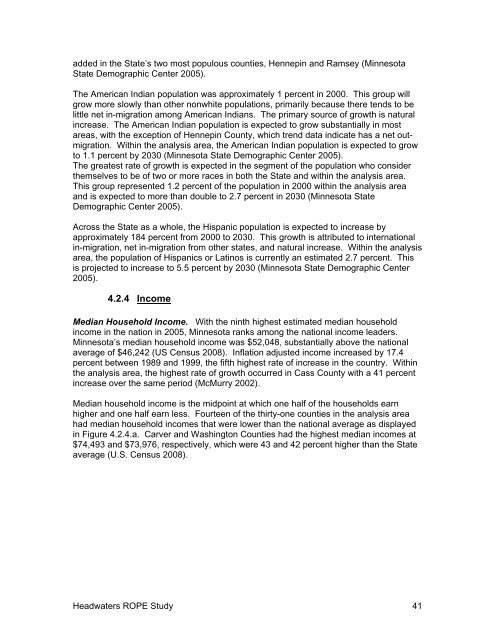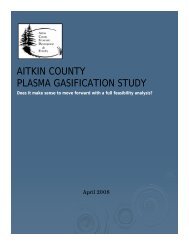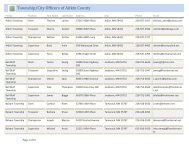Chapter 4: Affected Environment - Aitkin County Government
Chapter 4: Affected Environment - Aitkin County Government
Chapter 4: Affected Environment - Aitkin County Government
- No tags were found...
You also want an ePaper? Increase the reach of your titles
YUMPU automatically turns print PDFs into web optimized ePapers that Google loves.
added in the State’s two most populous counties, Hennepin and Ramsey (MinnesotaState Demographic Center 2005).The American Indian population was approximately 1 percent in 2000. This group willgrow more slowly than other nonwhite populations, primarily because there tends to belittle net in-migration among American Indians. The primary source of growth is naturalincrease. The American Indian population is expected to grow substantially in mostareas, with the exception of Hennepin <strong>County</strong>, which trend data indicate has a net outmigration.Within the analysis area, the American Indian population is expected to growto 1.1 percent by 2030 (Minnesota State Demographic Center 2005).The greatest rate of growth is expected in the segment of the population who considerthemselves to be of two or more races in both the State and within the analysis area.This group represented 1.2 percent of the population in 2000 within the analysis areaand is expected to more than double to 2.7 percent in 2030 (Minnesota StateDemographic Center 2005).Across the State as a whole, the Hispanic population is expected to increase byapproximately 184 percent from 2000 to 2030. This growth is attributed to internationalin-migration, net in-migration from other states, and natural increase. Within the analysisarea, the population of Hispanics or Latinos is currently an estimated 2.7 percent. Thisis projected to increase to 5.5 percent by 2030 (Minnesota State Demographic Center2005).4.2.4 IncomeMedian Household Income. With the ninth highest estimated median householdincome in the nation in 2005, Minnesota ranks among the national income leaders.Minnesota’s median household income was $52,048, substantially above the nationalaverage of $46,242 (US Census 2008). Inflation adjusted income increased by 17.4percent between 1989 and 1999, the fifth highest rate of increase in the country. Withinthe analysis area, the highest rate of growth occurred in Cass <strong>County</strong> with a 41 percentincrease over the same period (McMurry 2002).Median household income is the midpoint at which one half of the households earnhigher and one half earn less. Fourteen of the thirty-one counties in the analysis areahad median household incomes that were lower than the national average as displayedin Figure 4.2.4.a. Carver and Washington Counties had the highest median incomes at$74,493 and $73,976, respectively, which were 43 and 42 percent higher than the Stateaverage (U.S. Census 2008).Headwaters ROPE Study 41








